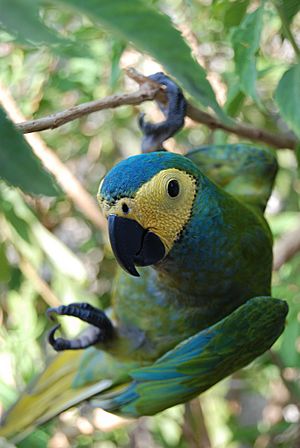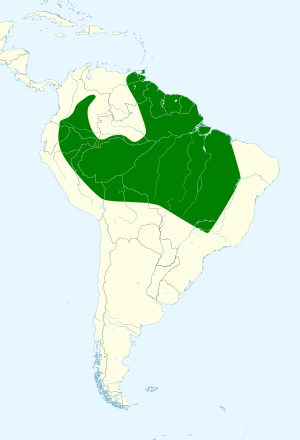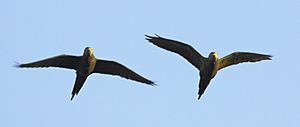Red-bellied macaw facts for kids
Quick facts for kids Red-bellied macaw |
|
|---|---|
 |
|
| In Goiânia, Brazil | |
| Conservation status | |
| Scientific classification | |
| Genus: |
Orthopsittaca
|
| Species: |
manilatus
|
 |
|
| Synonyms | |
|
Orthopsittaca manilata |
|
The red-bellied macaw (Orthopsittaca manilatus) is a medium-sized, mostly green parrot. It belongs to a group of large parrots from Central and South America called macaws. This bird is the biggest of the macaws often known as "mini-macaws." You can easily spot it by the large maroon patch on its belly, which gives it its name.
These macaws live only in the tropical Amazon region of South America. You can find them from Colombia all the way south to Peru and Bolivia, and across central Brazil. They also live on the Caribbean island of Trinidad. Their home is usually in swamp forests with moriche (or buriti) palms, or in sandy areas with palm groves. They rely completely on the Moriche palm for sleeping, eating, and building their nests.
Even though these birds are common in some places, their homes are sometimes cleared for farming or to make way for cattle. They are also sometimes caught to be sold as pets. It's important not to confuse them with the African red-bellied parrot, which is a smaller parrot with a similar name.
Contents
About the Red-bellied Macaw

The red-bellied macaw is a medium-sized bird. It weighs about 300 grams (11 ounces) and is about 46 centimeters (18 inches) long, including its long, pointed tail. Most of its feathers are green. The skin around its eyes and much of its face is bare and mustard-yellow. Its eyes have dark brown centers.
The top of its head is bluish. Its chin, throat, and upper chest are greyish with some green patterns. The most special part is the large maroon (dark reddish-brown) patch on its lower belly. The tail is long and gets narrower at the end. The feathers under its wings and tail are a dull olive yellow.
Adult macaws have dark-grey beaks, legs, and feet. Like other parrots, they have special feet called zygodactyl feet. This means two toes point forward and two point backward, which helps them grip branches. Male and female red-bellied macaws look alike, but males are usually a bit bigger and have larger heads. Young macaws are not as brightly colored as adults. They have a grey beak with a clear white stripe along the top of the upper beak.
Where They Live and Their Home
Red-bellied macaws live in a very large area across the Amazon Basin. This includes parts of Brazil, the Guianas (like Guyana, Suriname, and French Guiana), eastern Venezuela, and the island of Trinidad.
Their main home is in areas with many moriche palms. These palms are super important for them.
Red-bellied Macaw Behavior
Red-bellied macaws make loud, high-pitched screams. They often sleep together in large groups in moriche palm trees. You can see many of them flying to these sleeping spots at dawn (sunrise) and dusk (sunset). They pick big groups of these palms that have lots of holes made by woodpeckers. They all pile into these hollows to sleep, with about five to ten birds sharing one space.
Reproduction and Life Cycle
Red-bellied macaws build their nests inside hollows of dead moriche palm trees. A female usually lays two to four white eggs. She sits on the eggs for about 27 days until they hatch. The baby chicks stay in the nest for about 77 days after hatching before they are ready to fly. Young macaws become old enough to have their own babies when they are about 2 to 3 years old.
What They Eat
Their diet is almost entirely made up of the fruit and seeds from the moriche palm. In Trinidad, they also eat the fruit of the Caribbean royal palm. These fruits are full of carbohydrates and have almost no fat. They are also very high in something called beta-carotene, which is good for them.
Conservation Status
The red-bellied macaw is listed as "least concern" by the IUCN. This means they are not currently in danger of disappearing. We don't have an exact number of how many there are, but it seems their numbers in the wild are slowly going down.
Red-bellied Macaws as Pets
It can be very hard to keep these birds alive if they are caught from the wild and kept as pets. This is because they are very sensitive and need a special diet that is low in fat and high in carbohydrates, like the moriche palm fruit. Sadly, many birds caught for the pet trade do not survive. Even chicks born in captivity often have a hard time surviving.
If you want to learn more about this amazing bird, check out the links below!
See also
 In Spanish: Guacamayo de vientre rojo para niños
In Spanish: Guacamayo de vientre rojo para niños



